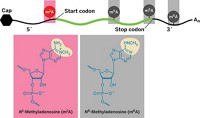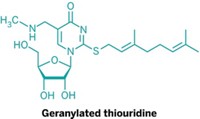Advertisement
Grab your lab coat. Let's get started
Welcome!
Welcome!
Create an account below to get 6 C&EN articles per month, receive newsletters and more - all free.
It seems this is your first time logging in online. Please enter the following information to continue.
As an ACS member you automatically get access to this site. All we need is few more details to create your reading experience.
Not you? Sign in with a different account.
Not you? Sign in with a different account.
ERROR 1
ERROR 1
ERROR 2
ERROR 2
ERROR 2
ERROR 2
ERROR 2
Password and Confirm password must match.
If you have an ACS member number, please enter it here so we can link this account to your membership. (optional)
ERROR 2
ACS values your privacy. By submitting your information, you are gaining access to C&EN and subscribing to our weekly newsletter. We use the information you provide to make your reading experience better, and we will never sell your data to third party members.
Biological Chemistry
Silence, Please
A variety of small RNAs turn down the volume on gene expression
by Celia Henry Arnaud
May 14, 2007
| A version of this story appeared in
Volume 85, Issue 20
CALL RNA the power behind the throne. DNA gets all the glory because it contains the instructions for life. But it turns out that RNA has been calling the shots. And the bossiest RNAs may be the short ones.
Small pieces of RNA regularly exercise their authority over gene expression by guiding the degradation of messenger RNA before it can be translated into protein by the cell's ribosomes. Given the hubbub over RNA interference in recent years, people could be forgiven for thinking that it's the only gene-silencing approach that harnesses short stretches of RNA, but they'd be wrong. Short interfering RNAs (siRNAs) are just one of several types of small RNA molecules that add a powerful layer of regulation to gene expression.
The main classes of small RNAs are siRNAs, microRNAs (sometimes abbreviated miRNA), and Piwi-interacting, or piRNAs. Although these various small RNAs are said to silence gene expression, David P. Bartel of the Whitehead Institute in Cambridge, Mass., suggests that the effect is better described as a dampening. "You can get much more complex patterns of gene expression by adding this additional layer of gene regulation," he says.
Scientists would like to learn enough about these different types of silencing RNAs to be able to take advantage of this natural, gene-regulating innovation for research or therapeutic purposes.
Phillip D. Zamore, a biochemist at the University of Massachusetts Medical School, in Worcester, has been surprised by the number of "authentic, biologically distinct classes of small RNAs" that have been identified to date. At the same time, he's also been surprised "by the number of times people have discovered something that clearly looked like siRNAs and given it a new name."
All of these small RNAs silence gene expression by stopping their larger messenger RNA counterparts from getting their message across. By interacting with a member of the Argonaute family of proteins, these small RNAs guide messenger RNA bearing a complementary sequence to a protein complex that cleaves it and/or prevents its translation into protein. These small RNAs are most easily differentiated on the basis of which Argonaute protein they interact with and on the basis of their biogenesis.
The most widely known of the small RNAs continue to be siRNAs. The enzyme Dicer cuts siRNAs from double-stranded RNA precursors. The siRNAs that result are 21 to 24 nucleotides long. Endogenous siRNAs have been found in plants, flies, and worms. Similar RNAs are not naturally found in mammalian cells, although such cells have machinery that can process them. This in-cell ability has spurred scientists to use synthetic siRNAs to silence mammalian gene expression.
MicroRNAs are a close cousin of siRNAs. They too are processed from double-stranded precursors, this time from the stem of an RNA hairpin, which is a stretch of RNA that folds back on itself. In animals, the enzyme Drosha recognizes the hairpin and cleaves it from the rest of the RNA transcript. That duplex is then exported into the cytoplasm, where Dicer cleaves it a second time, resulting in a final product that is the same length as siRNAs.
Unlike siRNAs, microRNAs are found in mammalian cells. In fact, siRNAs that are used as research reagents or drugs work "because the cell recognizes that duplex as a microRNA duplex," Bartel says. Even though mammalian cells contain no endogenous siRNAs, "the cell has the machinery to use siRNAs for silencing because it is continuously using microRNAs for that purpose." Scientists have also designed synthetic hairpin RNAs (shRNAs) that mimic microRNAs and might be useful as research reagents or therapeutics.

SCIENTISTS PREDICT that microRNAs may be involved in regulating as many as half of human genes. "There are a small number of microRNAs whose regulatory influence is so dramatic that without that microRNA, the organism is dead," Zamore says. For example, the lack of a particular microRNA has recently been shown to cause severe heart abnormalities in mice (Cell 2007, 129, 303). "Most microRNAs, we presume, will turn out to confer developmental and environmental robustness" to the organism, Zamore notes.
Identifying microRNAs is still a laborious process best done by nucleic acid sequencing. Computer algorithms alone can't adequately pinpoint them, because the genome encodes many more possible RNA hairpins than there are true microRNAs. "If you really want to know all the microRNAs, it looks like the best method is still experimental sequencing of tens of millions of small RNAs," Zamore says.
The most recently discovered type of silencing RNAs are piRNAs. At 24-31 bases each, piRNAs also are the longest of the known small RNAs. As their name suggests, these small RNAs interact with members of the Piwi subfamily of Argonaute proteins.
First discovered in fly testes, piRNAs were originally called repeat-associated siRNAs. Subsequently, they were found in mammalian testes, and the term piRNAs was coined. In Drosophila and fish, they have been found in both the male and female reproductive cells. So far, in mammals, piRNAs have been found only in testes. However, Bartel says, "I don't think people would be surprised if they were also found during mammalian egg development."
The origin of piRNAs remains mysterious. They are processed from single-stranded RNA. Many piRNAs are produced from the same sections of the genome, each spanning up to 100,000 bases. Biologists don't yet know what enzyme cuts the RNA strand into piRNAs, but they know it isn't Dicer. Different Piwi proteins favor RNA generated from different strands of the genome. Certain Piwi proteins prefer antisense RNA, whereas others prefer RNA from the sense strand.
"We know relatively little about how piRNAs function despite the proliferation of guesses in the discussion sections of papers," Zamore remarks. "Any individual piRNA species is probably of no consequence, but if you block the production of piRNAs generally, you usually render the animal infertile." Recent studies demonstrate that piRNAs are involved in the regulation of transposons, DNA sequences that can move to different locations in the genome.
Other small RNAs don't fit quite so easily into these broad categories. Two types found in worms are called tiny noncoding RNAs (tncRNAs) and 21U RNAs, discovered respectively by Victor R. Ambros of Dartmouth Medical School and Bartel. The tncRNAs are so named because they are found in regions of the genome that don't code for proteins. (Many other small RNAs come from the noncoding introns of protein-coding genes-that is, the part of the sequence that is removed during gene splicing.) The 21U RNAs, as their name suggests, are 21 nucleotides long and start with a uracil-containing nucleotide.
The tncRNAs appear to have triphosphate groups at their 5′ ends, suggesting that they are produced by RNA-dependent RNA polymerases. Worms have such polymerases, but many other animals don't, so these small RNAs may be unique to them. The function of tncRNAs remains unknown.
Likewise, no one yet knows the role of 21U RNAs. Researchers can easily identify them by genome sequencing because a particular motif appears in the DNA upstream from each one. Bartel cloned and sequenced more than 5,000 21U RNAs in worms, and from the motif, he predicts there are another 7,000. They are expressed at lower levels than other small RNAs, and each one tends to come from its own section of the genome. This means they don't cluster in the genome like piRNAs. Bartel also gave them the more generic name of diverse autonomously expressed RNAs (dasRNA), anticipating that similar RNAs might be found in other organisms. "Maybe in another species they'll have slightly different molecular characteristics," Bartel says. "They may not be exactly 21 nucleotides, and they may not always begin with a U."
Recent studies with synthetic small RNAs suggest that even more types may be out there. Synthetic antigene RNAs (agRNAs), described by David Corey of the University of Texas Southwestern Medical Center, in Dallas, can turn gene expression on or off, depending on the circumstances.
Corey designed synthetic agRNAs to home in on promoter regions on DNA. But he admits that he is unsure about what agRNAs actually target. Corey and John Rossi of the Beckman Research Institute at City of Hope, in Duarte, Calif., have shown that two Argonaute proteins are involved with transcriptional silencing by agRNAs. In light of these results, Corey says, "it's important to think about which other RNAs might be present inside a cell," referring in this case to the targets of various small RNAs.
A remaining challenge for scientists is learning enough about the origins and biochemistry of the various small RNAs to make synthetic versions of them that can be harnessed for research and possibly clinical purposes. So far, siRNAs and microRNAs are the only ones that scientists can effectively deliver to cells. "If you didn't know that microRNAs are processed from double-stranded precursors by Drosha and Dicer, it would be hard to produce them artificially because you wouldn't know what to deliver to the cell" to serve as a precursor, says Gregory J. Hannon of Cold Spring Harbor Laboratory, in Long Island, N.Y.
In contrast, scientists currently don't know how to make an RNA molecule that the cell will recognize as a piRNA. "We have some notion that they're produced from these long single-stranded precursors," Hannon says, "but we don't know what distinguishes a piRNA precursor from any other long single-stranded piece of RNA in the cell."
There's a lot that isn't known, but as RNA's multifaceted role in the cell becomes more apparent, the incentive to see the big picture only increases.





Join the conversation
Contact the reporter
Submit a Letter to the Editor for publication
Engage with us on Twitter